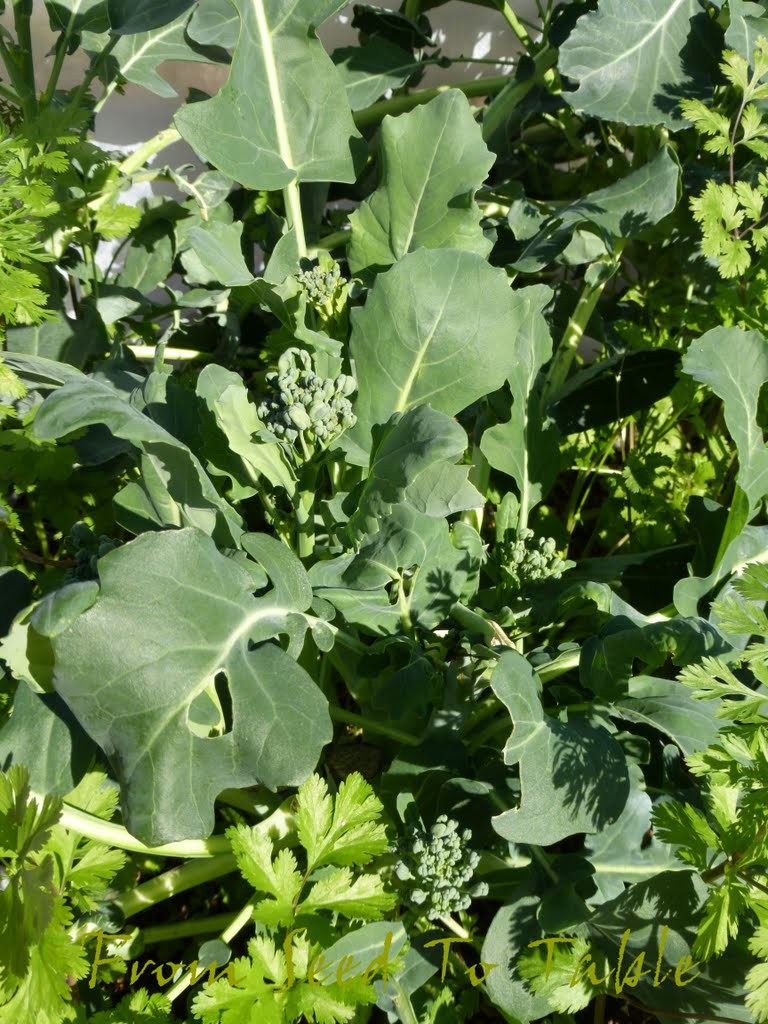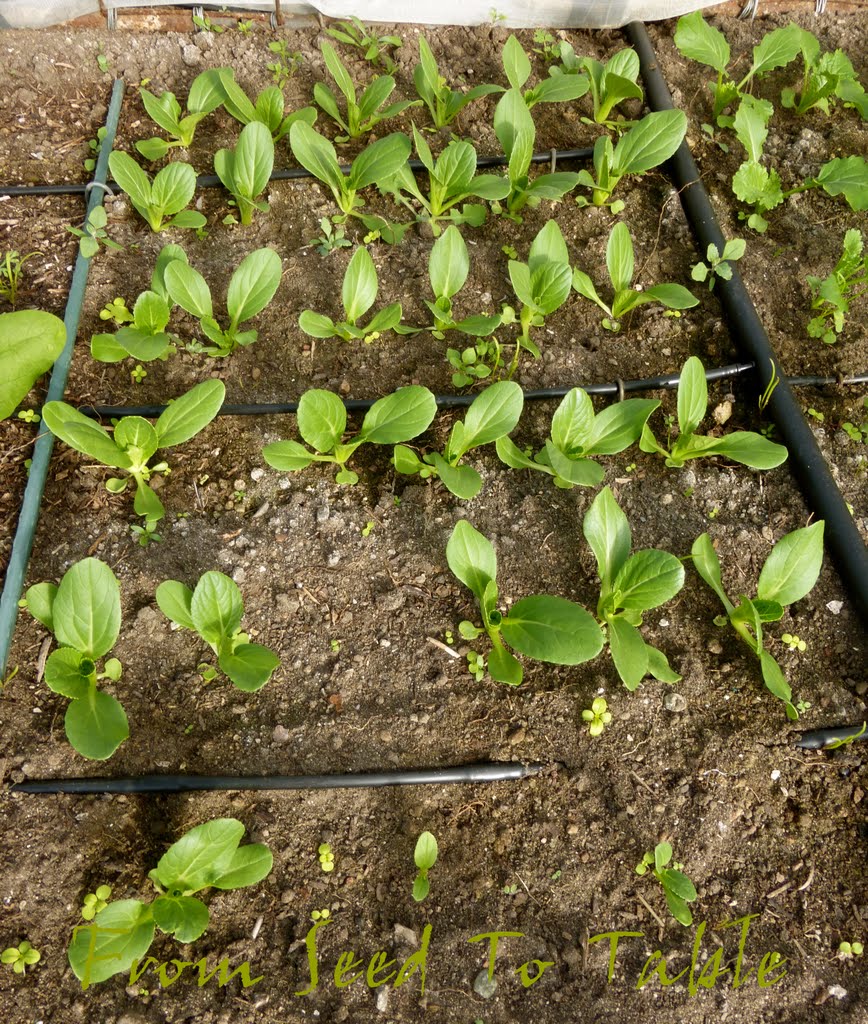 |
| Bed #1 |
Here's the carrot patch, under cover to keep the birds from pecking all the foliage away. There's also a few parsnips in there - the only ones that germinated from an old packet of seeds that I tried to get going before I resorted to carrots. Look at the favas that I sowed back in November, they're in full bloom already. The unusual warm weather that we've been guiltily enjoying this winter has prompted them to bloom extra early.
There's two celeriac plants remaining on the left and the Dorato D'Asti celery is on the right.
I'm experimenting with wrapping the stems of the celery, some with Agribon and others with newspaper. I've been harvesting the stalks on a cut-and-come-again basis and the stalks have been splaying out which exposes them to more light. The stalks were staying short and getting rather green so I gathered them up and wrapped them which is helping them to lengthen a bit more and is blanching them to the pale green/gold color that their name implies.
Here's one of the bunches showing that green/gold hue. My main concern with tying them up like this is that it would make a nice comfy home for earwigs or other critters but that hasn't been a problem yet.
Further down the bed is the Di Ciccio broccoli that I started back in July for fall and winter harvests.
It's just about finished now, here's a few shoots that were harvested just after I did the photo shoot for this post. I picked every single shoot that I could find on the plants.
Finally, the last Romanesco plant left to be harvested.
Here's a view of the funky "head", really just a loose collection of shoots. It looks weird but it's tasty.
Moving along to bed #2. The Sonora wheat remains under protective bird netting. Look at the brown grass on the hillside. If this were a normal winter the hillside would be covered with green grass and there would be wild flowers. This year there is barely a hint of green grass struggling to grow and nary a flower to be found.
I laid newspaper down between the rows of onions and garlic to help suppress the chamomile that insists on growing in there. Note to self - don't let the chamomile bloom so profusely and drop its seed everywhere again. It seemed like a never ending task to keep weeding it out. On the plus side, the newspaper should help to conserve soil moisture - oh so important this year. That bare looking patch boxed in between the wheat, the black nursery flats, and the garlic is the struggling shallot patch. I waited too long to plant the sets out and they were not in good shape. I may just clean that out and plant some runner beans. The flats are covering some poppy seedlings.
I set out about 60 onion plants to harvest as hopefully mature onions and then I had extras so they are bunched together to harvest as young onions.
Bed #3. The Red Fife wheat is coming along nicely under its netting. I set up another Micromesh tunnel to protect newly planted out saladings.
There's three varieties of beets - Golden, Chioggia, and Red Baron. Plus one very small planting of Yu Choy (edible rape). My Yu Choy seeds are a bit old and I didn't get great germination so it's just a tiny patch. The beets were started in paper pots and planted out when they had a couple of true leaves.
 |
| Pea Shoots (Dou Miao) |
 |
| Sweetie Baby Romaine |
 |
| Rhapsody and Kagraner butterhead lettuces |
Snow pea plants that were sown in paper pots and set out last fall (November?) have really taken off now. I have to keep the plants under wraps to keep the birds from devouring the foliage.
They are in full production now.
The other Micromesh tunnel has been doing an admirable job of protecting the first round of saladings that I sowed through the month of January. The Tuscan arugula which was direct sown on January 16th is a lovely patch of baby plants perfect for harvesting now. I thought that I had sown them rather too thickly, but now that I've found I love them harvested as babies I've decided that this is the way to grow. These plants were sown from seeds that I saved.
Looking further down the tunnel is first a bare looking patch where I sowed Golden Corn Salad. I think I covered them with too thick of a layer of fine compost. The seeds are germinating nicely all around the edge of the area where the compost is thin but only a few seedlings are emerging where I wanted them to grow. (Another lesson learned). Beyond the corn salad is another variety of arugula.
This is "Speedy" arugula, a variety with the attractive lobed leaves of wild arugula but the more mild flavor of the smooth leafed cultivated varieties. I tasted a few leaves when I took these photos and it is indeed nice and mild, just the way I like it. And it is indeed speedy, these plants were direct seeded on January 20th. I managed to sow these seeds more thinly than the Tuscan arugula, a feat made easier because the seeds are quite pricey. This is an open pollinated variety so I'm going to let these plants go to seed and collect them so that I can grow as much as I like.
The next patch was sown with Ruby Streaks Mizuna and Purple Pac Choy on February 5. Both of these are quick maturing varieties that are good harvested as baby vegetables and both are supposed to be good as salad greens.
 |
| Purple Pac Choy (front) and Ruby Streaks Mizuna (back) |
The same goes for the Green Fortune Pak Choi.
The four varieties of chard won't be producing for a while. Clockwise from the top left are Flamingo, Italian Silver Rib, Golden, and Peppermint Stick. Beyond the chard are fennel seedlings amongst a few weedy things.
I've got three rows of spinach going, each row a different variety - Summer Perfection, Verdil, and Monstreux D'Viroflay.
And finally, bed #4, recently sown with a cover crop blend.
I will allow this mix to grow until about mid-April and then turn it in as a green manure. It should have enough time to break down so that I can plant my solanums in this bed sometime around the end of May or the beginning of June.
That's the garden at the end of February, perhaps a bit further along than it would be if we were having a more normal winter. I think it's in much better shape than it was at this time last year, however, I was traveling for the last week of January and the first two weeks of February last year so I wasn't around to get an early spring garden going. Back in February 2012 I was clearing out my beds and moving soil aside so that I could have the old planting beds replaced with the big boxes that I have now. 2011 was a rather mixed bag in the garden with more overwintered vegetables but fewer new starts - and big surprise, we had snow in the first week of March (I forgot about that, that's one reasone it's fun to blog about the garden). 2010 had somewhat normal rainfall and the vegetables were growing without any supplemental irrigation. 2009 was a wet one and it seemed that a river ran through the garden. It seems that I didn't really have much by way of spring sowings going in February that year - probably too wet to get out to the garden. And that's about as far back as I've done garden tours and it seems that I really don't have a "normal" year to compare to!















































































